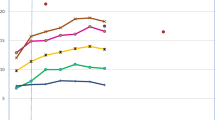Abstract
Background and aims: To identify factors associated with falls in non-bedridden nursing home residents in Hong Kong, and to examine whether restraints are protective against falls. Methods: Cross-sectional survey of 1710 nursing home residents, examining factors associated with falls and use of restraints, as documented in the RAI questionnaire. Results: Vision impairment is highly associated with falls (OR 1.75, 95% CI 1.29–2.34), whereas older age (OR 1.03, 95% CI 1.01–1.05), dementia (OR 1.46, 95% CI 1.05–2.04), and intake of psychotropics (OR 1.52, 95% CI 1.06–2.17) were moderately associated. Women were less likely to fall (OR 0.65, 95% CI 0.48–0.90). Walking with aids and taking more medications were not associated with falls in this population. Restraints were used in 68%. The use of any type of restraint was marginally associated with fewer falls (OR 0.73, 95% CI 0.53–1.00). Conclusions: Men, those with impaired vision, dementia or taking psychotropic drugs were more likely to fall. Restraints are very commonly used in Hong Kong nursing homes. Although their use was associated with fewer falls, their effect on preventing falls could not be established in this cross-sectional study.
Similar content being viewed by others
References
Ho SC, Woo J, Chan SSG, Yuen YK, Sham A. Risk factors for falls in the Chinese elderly population. J Gerontol Med Sci 1996; 51A: M195–8.
Hanlon JT, Landerman LR, Fillenbaum GG, Studenski S. Falls in African American and white community-dwelling elderly residents. J Gerontol Med Sci 2002; 57A: M473–8.
Cesari M, Landi F, Torre S, Onder G, Lattanzio F, Bernabei R. Prevalence and risk factors for falls in an older community-dwelling population. J Gerontol Med Sci 2002; 57A: M722–6.
Rubernstein L, Josephson KR. The epidemiology of falls and syncope. Clin Geriatr Med 2002; 18: 141–58.
Chu LW, Chi I, Chiu AYY. Incidence and predictors of falls in the Chinese elderly. Ann Acad Med Singapore 2005; 34: 60–72.
Lee JSW, Kwok T, Leung PC, Woo J. Medical illnesses are more important than medications as risk factors of falls in older community dwellers: a cross-sectional study. Age Ageing 2006; 35: 246–51.
Gryfe CI, Amies A, Ashley MJ. A longitudinal study of falls in an elderly population:I. Incidence and morbidity. Age Ageing 1977; 6: 201–10.
Tinetti ME. Factors associated with serious injury during falls by ambulatory nursing home residents. J Am Geriatr Soc 1987; 35: 644–8.
Thapa PB, Brockman KG, Gideon P, Fought RL, Ray WA. Injurious falls in nonambulatory nursing home residents: a comparative study of circumstances, incidence and risk factors. J Am Geriatr Soc 1996; 44: 273–8.
Kallin K, Lundin-Olsson L, Jensen J, Nyberg L, Gustafson Y. Predisposing and precipitating factors for falls among older people in residential care. Public Health 2002; 116: 263–71.
Kallin K, Gustafson Y, Sandman PO, Karlsson S. Drugs and falls in older people in geriatric care settings. Aging Clin Exp Res 2004; 16: 270–6.
Fonad E, Wahlin TB, Winblad B, Emami A, Sandmark H. Falls and fall risk among nursing home residents. J Clin Nurs 2008; 17: 126–34.
Eriksson S, Gustafson Y, Lundin-Olsson L. Risk factors for falls in people with and without a diagnosis of dementia living in residential care facilities: a prospective study. Arch Gerontol Geriatr 2008; 46: 293–306.
Capezuti E, Strumpf NE, Evans LK, Grisso JA, Maislin G. The relationship between physical restraint removal and falls and injuries among nursing home residents. J Gerontol Med Sci 1998; 53: M47–52.
Cali CM, Kiel DP. An epidemiologic study of fall-related fractures among institutionalized older people. J Am Geriatr Soc 1995; 43: 1336–40.
Tinetti, ME, Liu WL, Ginter SF. Mechanical restraint use and fall-related injuries among residents of skilled nursing facilities. Ann Intern Med 1992; 116: 369–74.
Woo J, Hui E, Chan F, Chi I, Sham A. Use of restraints in long-term residential care facilities in Hong Kong SAR, China: predisposing factors and comparison with other countries. J Gerontol Med Sci 2004; 59: M921.
Morris JN, Hawes C, Fries BE, et al. Designing the national resident assessment instrument for nursing facilities. Gerontologist 1990; 30: 293–307.
Morris JN, Nonemaker S, Murphy K, et al. A commitment to change: revision of HCFA’s RAI. J Am Geriatr Soc 1997; 45: 1011–6.
Chou KL, Chi I, Leung ACT, Wu YM, Liu BCP. Validation of minimum dataset for nursing homes for Hong Kong Chinese elders. Clin Gerontol 2001; 23: 43–54.
Stillwell E. Nurses’ education related to the use of restraints. J Gerontol Nurs 1991; 17: 23–6.
Karlsson S, Nyberg L, Sandman PO. The use of physical restraints in elder care in relation to fall risk. Scand J Caring Sci 1997; 11: 238–42.
Morris JN, Fries BE, Morris SA. Scaling ADLs within the MDS. J Gerontol Med Sci 1999; 54A: M546–53.
Morris JN, Fries BE, Mehr DR, et al. MDS cognitive performance scale. J Gerontol Med Sci 1994; 49: M174–82.
Chi I. Cross-national comparison of the profiles of nursing home residents. Geriatr Gerontol Int 2004; 4: S286–8.
Rosendahl E, Lundin-Olsson L, Kallin K, Jensen J, Gustafson Y, Nyberg L. Prediction of falls among older people in residential care facilities by the Downton index. Aging Clin Exp Res 2003; 15: 142–7.
Ejaz FK, Jones JA, Rose MS. Falls among nursing home residents: an examination of incident reports before and after restraint reduction programs. J Am Geriatr Soc 1994; 42: 960–4.
Author information
Authors and Affiliations
Corresponding author
Rights and permissions
About this article
Cite this article
Lee, J.S.W., Hui, E., Chan, F. et al. Associated factors of falls in nursing home residents in Hong Kong and the role of restraints: a cross-sectional survey using the ResidentAssessment Instrument (RAI) 2.0. Aging Clin Exp Res 20, 447–453 (2008). https://doi.org/10.1007/BF03325151
Received:
Accepted:
Published:
Issue Date:
DOI: https://doi.org/10.1007/BF03325151




